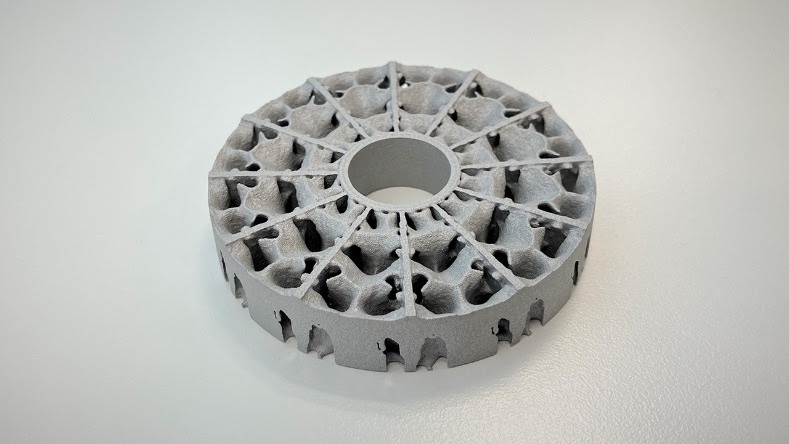Two powerhouses in additive manufacturing (AM) and global industry at-large, Ricoh and Siemens, have started collaborating to leverage Siemens Digital Industries Software and the Siemens’ Additive Manufacturing Network for Ricoh’s metal binder jetting (MBJ) platform. The beginning of the collaboration involves Ricoh’s use of Siemens’ digitalization solutions to optimize its MBJ workflow for aluminum parts output.
Via Siemens’ Brownfield Connectivity solution, Ricoh has started to monitor, collect, and store data related to the quality control of each step of the MBJ process. Both Siemens and Ricoh are especially interested in commercializing the solutions they’ve jointly developed for electrification applications, and EVs, in particular.

In a press release about the collaboration between Siemens and Ricoh for digital workflow management of MBJ for aluminum parts, Zvi Feuer, senior VP of digital manufacturing software at Siemens Digital Industries Software, said, “The production of aluminum parts is a holy grail for the additive industry and we’re delighted that Ricoh has chosen Siemens’ Additive Manufacturing Network capabilities from the Siemens Xcelerator portfolio of industry software to help them commercialize a much sought-after process. Our collaboration with Ricoh will apply its expertise in [AM] with our knowledge and experience in delivering additive-specific operations management across a wide spectrum of industries — from order capture, production planning, and manufacturing to part delivery transaction closure.”
Tokutaro Fukushima, GM of the AM Business Center in Ricoh’s Futures Business Unit, said, “Ricoh will enable our customers to manufacture innovative aluminum components that have never been produced before by any process and will work with them to realize new customer value in the area of electrification of EVs and other forms of mobility.”

As seems to happen any time that Siemens is involved, this collaboration brings together some of the most significant threads currently at the center of focus in the AM sector. Upon reflection of the last year of AM progress, MBJ for decarbonization, as well as digital traceability of parts in every area of AM, are two of the themes from 2023 that seem poised to become even more fundamental to the sector’s activities in 2024.
Along those lines, then, it is intriguing to see those separate themes explicitly combined in this one collaboration, particularly since the primary market involved is EVs — another major theme from 2023 that should only gain further traction next year. While the Siemens Digital Industries Software VP quoted above is certainly correct that aluminum parts are “a” holy grail for AM, “the” holy grail, from a long-term perspective, may very well be the deployment of AM for EV supply chains.
This is by no means just because of the significance of the EV market, itself. Even more importantly, it is because the qualitative makeup of the manufacturing ecosystem for EVs is certain to have incalculable knock-on effects for all other areas of advanced manufacturing. The goals for the EV market are to decarbonize and scale up and incorporate automation to the fullest extent possible — all while digitally tracking the process at every step in the supply chain. All the other areas of global industry also need to know how to thread that exact needle, and they will all be taking their cues from the EV market.
Subscribe to Our Email Newsletter
Stay up-to-date on all the latest news from the 3D printing industry and receive information and offers from third party vendors.
Print Services
Upload your 3D Models and get them printed quickly and efficiently.
You May Also Like
Johns Hopkins University Researchers Develop HyFAM Technology
Two scientists from Johns Hopkins University, Nathan C. Brown and Jochen Mueller, have developed a hybrid manufacturing technology they call HyFam, or Hybrid Formative Additive Manufacturing. Their work on this technology...
3D Printing G-Code Gets an Upgrade: T-Code
Good old G-Code still manages many 3D printers, great and small. Just like the STL, it’s a standard that enables collaboration while also holding the additive manufacturing (AM) industry back....
AM Rewind: The Biggest News and Trends of 2024
After a sluggish 2023, driven by persistent inflation and geopolitical tensions, 2024 has seen some recovery. Economic growth climbed from about 2.8 percent in 2023 to a modest 3.2 percent...
Metal Wire 3D Printer OEM ValCUN Announces Plans for 2025 Expansion
ValCUN, a Belgian original equipment manufacturer (OEM) of wire-based metal additive manufacturing (AM) hardware, has announced that the company has entered the next phase of its growth trajectory, making key...

































